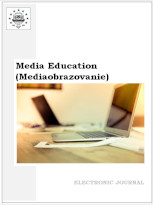1 June 13, 2025
1. Febriyanti Bifakhlina, Resty Jayanti Fakhlina, Lolytasari Lolytasari
Public Information Literacy in Online News Media Comments: Qualitative Research on the Role and Influence of Buzzers on Narratives and Information
Media Education (Mediaobrazovanie). 2025. 21(2): 170-177.
Number of views: 166 Download in PDF
2. Irina ChelyshevaMedia Education (Mediaobrazovanie). 2025. 21(2): 170-177.
Abstract:
This study examines the role of buzzers in comments on online news media and their impact on the narratives and information conveyed to the public. Using a qualitative approach, the research employs content analysis and interviews to explore the interaction dynamics between buzzers and other users in the comment sections. The findings indicate that buzzers often dominate the comment space, creating an illusion of public support for specific issues and influencing public perception. Additionally, this study identifies the strategies buzzers employ to promote specific agendas and the responses of news media in managing these comments. These findings highlight the importance of understanding the presence of buzzers in online news, particularly in maintaining the quality of information and public discourse. With the increasing use of digital platforms, the public is expected to become more critical in filtering the information they receive. This research contributes to the literature on communication and media, offering recommendations for news media to take greater responsibility in moderating comments. Ultimately, the results aim to raise public awareness regarding the influence of buzzers and the importance of media literacy in the digital age.
This study examines the role of buzzers in comments on online news media and their impact on the narratives and information conveyed to the public. Using a qualitative approach, the research employs content analysis and interviews to explore the interaction dynamics between buzzers and other users in the comment sections. The findings indicate that buzzers often dominate the comment space, creating an illusion of public support for specific issues and influencing public perception. Additionally, this study identifies the strategies buzzers employ to promote specific agendas and the responses of news media in managing these comments. These findings highlight the importance of understanding the presence of buzzers in online news, particularly in maintaining the quality of information and public discourse. With the increasing use of digital platforms, the public is expected to become more critical in filtering the information they receive. This research contributes to the literature on communication and media, offering recommendations for news media to take greater responsibility in moderating comments. Ultimately, the results aim to raise public awareness regarding the influence of buzzers and the importance of media literacy in the digital age.
Number of views: 166 Download in PDF
Media Education Model for Studying Images of Family and Family Education in Russian Feature Films (1920–2020)
Media Education (Mediaobrazovanie). 2025. 21(2): 178-186.
Number of views: 107 Download in PDF
3. Alexander FedorovMedia Education (Mediaobrazovanie). 2025. 21(2): 178-186.
Abstract:
The article presents the structural components and the content of the media education model for studying the images of family and family education in Russian feature films (1920–2020). The author analyzes the main theoretical approaches, methodological and practical aspects of reflecting the images of family and family education in Russian cinematography in media education of university students. The construction of a media education model is based on the synthesis of methodological approaches to media education, including cultural, semiotic, ethical approaches, and the theory of critical thinking. Reliance on these theories is predetermined by the main tasks of media education for the younger generation, consisting in expanding the socio-cultural framework of media education and enhancing the ability to independently search, select, analyze, interpret and create audiovisual media texts, use media resources for personal self-development and professional self-improvement. One of the key factors determining the relevance of this model is the psychological and pedagogical possibilities of using feature films in youth education. The educational function of Russian feature films is of great significance in the professional training of future teachers, psychologists, and organizers of work with youth. The inclusion of media education is aimed at teaching university students understanding and assessing what is seen on the screen and creative perception of media reality. This process plays a special role in analysing films on family issues, since it preserves and strengthens the family institution, family traditions of upbringing, and family values. In this regard, the study and analysis of feature films about family and family upbringing, which are imbued with the best ideas and ideals, can become an important tool for introducing the younger generation to a value-based attitude towards creating and strengthening family relationships, increasing the level of parental responsibility for the younger generation.
The article presents the structural components and the content of the media education model for studying the images of family and family education in Russian feature films (1920–2020). The author analyzes the main theoretical approaches, methodological and practical aspects of reflecting the images of family and family education in Russian cinematography in media education of university students. The construction of a media education model is based on the synthesis of methodological approaches to media education, including cultural, semiotic, ethical approaches, and the theory of critical thinking. Reliance on these theories is predetermined by the main tasks of media education for the younger generation, consisting in expanding the socio-cultural framework of media education and enhancing the ability to independently search, select, analyze, interpret and create audiovisual media texts, use media resources for personal self-development and professional self-improvement. One of the key factors determining the relevance of this model is the psychological and pedagogical possibilities of using feature films in youth education. The educational function of Russian feature films is of great significance in the professional training of future teachers, psychologists, and organizers of work with youth. The inclusion of media education is aimed at teaching university students understanding and assessing what is seen on the screen and creative perception of media reality. This process plays a special role in analysing films on family issues, since it preserves and strengthens the family institution, family traditions of upbringing, and family values. In this regard, the study and analysis of feature films about family and family upbringing, which are imbued with the best ideas and ideals, can become an important tool for introducing the younger generation to a value-based attitude towards creating and strengthening family relationships, increasing the level of parental responsibility for the younger generation.
Number of views: 107 Download in PDF
Zbyněk Brynych: Zigzags of Film Directing
Media Education (Mediaobrazovanie). 2025. 21(2): 187-194.
Number of views: 130 Download in PDF
4. Ilya HazanovMedia Education (Mediaobrazovanie). 2025. 21(2): 187-194.
Abstract:
This article analyzes the creative path of one of the most famous Czechoslovak directors – Zbyněk Brynych (1927 – 1995): from his first experiments with newsreels to the “thaw” period; from his masterpieces of the 1960s to his emigration to the FRG, where (in the late 1960s and early 1970s) he directed several largely experimental films; from the period of his return to Czechoslovakia, where he became actively involved in the subject of “normalization”, to the final period, when he spent the last years of his life making detective series on television in the FRG. Thus, from one of the leaders of the Czechoslovak New Wave of 1960s (Transport from Paradise, ... and the fifth horseman is Fear, I, Justice), Zbyněk Brynych in the 1970s – 1980s turned into a rather ordinary director of ordinary films (What Color Is Love?, The Night of Orange Lights, Romance for a Crown, Anger, Accused and Suspect, Who Comes at Midnight, The Halftime of Happiness). The author concludes that the example of Zbyněk Brynych’s winding creative path shows that the adaptation of an artist to the rules and opportunities of different periods of societies and countries can lead both to outstanding results and to the fading of the author's potential and desire to experiment.
This article analyzes the creative path of one of the most famous Czechoslovak directors – Zbyněk Brynych (1927 – 1995): from his first experiments with newsreels to the “thaw” period; from his masterpieces of the 1960s to his emigration to the FRG, where (in the late 1960s and early 1970s) he directed several largely experimental films; from the period of his return to Czechoslovakia, where he became actively involved in the subject of “normalization”, to the final period, when he spent the last years of his life making detective series on television in the FRG. Thus, from one of the leaders of the Czechoslovak New Wave of 1960s (Transport from Paradise, ... and the fifth horseman is Fear, I, Justice), Zbyněk Brynych in the 1970s – 1980s turned into a rather ordinary director of ordinary films (What Color Is Love?, The Night of Orange Lights, Romance for a Crown, Anger, Accused and Suspect, Who Comes at Midnight, The Halftime of Happiness). The author concludes that the example of Zbyněk Brynych’s winding creative path shows that the adaptation of an artist to the rules and opportunities of different periods of societies and countries can lead both to outstanding results and to the fading of the author's potential and desire to experiment.
Number of views: 130 Download in PDF
The Image of the Teacher in Soviet Feature Films about the War
Media Education (Mediaobrazovanie). 2025. 21(2): 195-203.
Number of views: 112 Download in PDF
5. Adamkolo Mohammed Ibrahim, Nura Ibrahim, Abubakar Tijjani IbrahimMedia Education (Mediaobrazovanie). 2025. 21(2): 195-203.
Abstract:
In Russia, 2025 has been declared the Year of Defender of the Fatherland. One of the goals of educational institutions is to preserve the memory of the heroic victory in the Great Patriotic War as an element of spiritual continuity of generations. Patriotism in Russia is both the foundation of state ideology and a natural component of the worldview of citizens. The article is devoted to Soviet feature films about the Great Patriotic War, which depict teachers. Among the typical characteristics of the teacher's image are moral fortitude, loyalty to pedagogical service, spiritual closeness to children, and activity in the struggle. The main contribution of the teacher to the victory is the moral education of young people. The author substantiates that the idealization of the teacher's image is not a distortion of reality, but a necessary way of creating an artistic image in cinema. In the context of developing media literacy of future teachers, one form of professional training in the process of studying the image of teachers in Soviet cinema is proposed educational project with elements of discussion, including a retrospective and pedagogical analysis of the personal, professional and communicative culture of teachers shown in Soviet war films.
In Russia, 2025 has been declared the Year of Defender of the Fatherland. One of the goals of educational institutions is to preserve the memory of the heroic victory in the Great Patriotic War as an element of spiritual continuity of generations. Patriotism in Russia is both the foundation of state ideology and a natural component of the worldview of citizens. The article is devoted to Soviet feature films about the Great Patriotic War, which depict teachers. Among the typical characteristics of the teacher's image are moral fortitude, loyalty to pedagogical service, spiritual closeness to children, and activity in the struggle. The main contribution of the teacher to the victory is the moral education of young people. The author substantiates that the idealization of the teacher's image is not a distortion of reality, but a necessary way of creating an artistic image in cinema. In the context of developing media literacy of future teachers, one form of professional training in the process of studying the image of teachers in Soviet cinema is proposed educational project with elements of discussion, including a retrospective and pedagogical analysis of the personal, professional and communicative culture of teachers shown in Soviet war films.
Number of views: 112 Download in PDF
Cinematic Soft Power, Media Literacy and Cultural Diplomacy: A Comparative Analysis of the Influence of Kannywood, Nollywood and Bollywood on Public Perceptions and Policy Formation
Media Education (Mediaobrazovanie). 2025. 21(2): 204-222.
Number of views: 211 Download in PDF
6. Ella Kulikova, Ludmila BrusenskayaMedia Education (Mediaobrazovanie). 2025. 21(2): 204-222.
Abstract:
This article examines the multifaceted role of cinema as an instrument of cultural diplomacy, focusing on three prominent film industries: Kannywood, Nollywood and Bollywood. Drawing on Soft Power Theory, Cultural Imperialism Theory and Transnationalism Theory, the study explores how these cinematic sectors project national cultural identities and values to global audiences, thereby influencing public perceptions and policy decisions. In addition, the research incorporates the concept of media literacy – the capacity to critically access, analyse and evaluate media messages – to assess how informed audiences engage with cinematic narratives and deconstruct underlying ideological messages. Through a comprehensive review of literature, film analyses and interviews with industry stakeholders, the study investigates the mechanisms through which these film industries promote intercultural dialogue, stimulate economic development and influence diplomatic engagements. The findings reveal that while Kannywood, Nollywood and Bollywood serve as potent soft power assets that facilitate cultural exchange and economic integration, they also raise critical questions regarding cultural homogenisation and the reinforcement of hegemonic narratives. This study underscores the importance of developing coherent cultural policies that support creative expression and robust media education, thereby preserving cultural diversity and authenticity in an increasingly globalised digital era.
This article examines the multifaceted role of cinema as an instrument of cultural diplomacy, focusing on three prominent film industries: Kannywood, Nollywood and Bollywood. Drawing on Soft Power Theory, Cultural Imperialism Theory and Transnationalism Theory, the study explores how these cinematic sectors project national cultural identities and values to global audiences, thereby influencing public perceptions and policy decisions. In addition, the research incorporates the concept of media literacy – the capacity to critically access, analyse and evaluate media messages – to assess how informed audiences engage with cinematic narratives and deconstruct underlying ideological messages. Through a comprehensive review of literature, film analyses and interviews with industry stakeholders, the study investigates the mechanisms through which these film industries promote intercultural dialogue, stimulate economic development and influence diplomatic engagements. The findings reveal that while Kannywood, Nollywood and Bollywood serve as potent soft power assets that facilitate cultural exchange and economic integration, they also raise critical questions regarding cultural homogenisation and the reinforcement of hegemonic narratives. This study underscores the importance of developing coherent cultural policies that support creative expression and robust media education, thereby preserving cultural diversity and authenticity in an increasingly globalised digital era.
Number of views: 211 Download in PDF
Argumentative Discourse of a Media Review
Media Education (Mediaobrazovanie). 2025. 21(2): 223-231.
Number of views: 140 Download in PDF
7. Galina MikhalevaMedia Education (Mediaobrazovanie). 2025. 21(2): 223-231.
Abstract:
Review, including media reviews, are traditionally analytical genre. Today, literary, artistic and professional art history magazines have lost their leading role in cultural processes. Media are increasingly becoming platforms for reviewing, which inevitably leads to a transformation of the genre and a lowering of the acceptable standard. Today, an expanded view has been adopted, according to which even the texts of announcements and annotations have begun to be included in reviews. The article raises the issue about the essence of the analysis that recipients expect from a review, and the essence of arguments acceptable in this genre, since it is here that the problem of evidentiary interpretation and verification of review author’s opinion on a particular work is the most acute. Arguments to the logos, factual argumentation, and the possibilities of a comparison topos are used to correlate the characteristics of a reviewed artifact with aesthetic criteria and social needs. This correlation includes both methods of inductive reasoning, when a conclusion is based on a set of presented facts, and methods of deductive reasoning, based on the truth of generally valid positions. The article examines the features of argumentative discourse based on literary, theatrical, television and film reviews published in the media. The article examines the features of argumentative discourse based on literary, theatrical, TV and film reviews published in media (first of all in first of all in Literary Newspaper, Komsomol Truth, Arguments of the Week). Semantic-stylistic and cognitive-pragmatic analysis is used. The problem of media literacy formation is in the centre of attention in modern society. The review culture is closely connected with media literacy formation and media education including literary and media critics. It is necessary for this to provide training, aimed at the formation of stable skills of perception and analysis. It is necessary to identify directions of media educational work that can proceed in creating the platform for teaching media literacy; to analyze media education technologies that can be used when creating the platform for teaching media literacy.
Review, including media reviews, are traditionally analytical genre. Today, literary, artistic and professional art history magazines have lost their leading role in cultural processes. Media are increasingly becoming platforms for reviewing, which inevitably leads to a transformation of the genre and a lowering of the acceptable standard. Today, an expanded view has been adopted, according to which even the texts of announcements and annotations have begun to be included in reviews. The article raises the issue about the essence of the analysis that recipients expect from a review, and the essence of arguments acceptable in this genre, since it is here that the problem of evidentiary interpretation and verification of review author’s opinion on a particular work is the most acute. Arguments to the logos, factual argumentation, and the possibilities of a comparison topos are used to correlate the characteristics of a reviewed artifact with aesthetic criteria and social needs. This correlation includes both methods of inductive reasoning, when a conclusion is based on a set of presented facts, and methods of deductive reasoning, based on the truth of generally valid positions. The article examines the features of argumentative discourse based on literary, theatrical, television and film reviews published in the media. The article examines the features of argumentative discourse based on literary, theatrical, TV and film reviews published in media (first of all in first of all in Literary Newspaper, Komsomol Truth, Arguments of the Week). Semantic-stylistic and cognitive-pragmatic analysis is used. The problem of media literacy formation is in the centre of attention in modern society. The review culture is closely connected with media literacy formation and media education including literary and media critics. It is necessary for this to provide training, aimed at the formation of stable skills of perception and analysis. It is necessary to identify directions of media educational work that can proceed in creating the platform for teaching media literacy; to analyze media education technologies that can be used when creating the platform for teaching media literacy.
Number of views: 140 Download in PDF
Evolution of Family Images in Russian Soviet and Post-Soviet Feature Films
Media Education (Mediaobrazovanie). 2025. 21(2): 232-242.
Number of views: 102 Download in PDF
8. Smita Sharma, Avneesh KumarMedia Education (Mediaobrazovanie). 2025. 21(2): 232-242.
Abstract:
The research investigates the evolution of screen family images in Russian feature films of the Soviet and post-Soviet periods and the use of the hermeneutic analysis of audiovisual media texts in studying films by university students. Hermeneutic analysis allows students to consider this evolution through the interpretation of symbols, signs and images that appear in films, as well as through the historical and cultural contexts. Moreover, the hermeneutic approach applied in media studies enables students to consider screen family images not only as a result of cultural and historical changes, but also as a way of interpreting social and family values. The family portrayal in Soviet and post-Soviet Russian feature films has evolved in response to the political, social, and economic changes. Soviet films often depicted the family as part of a broader socialist or patriotic project, while post-Soviet films reflect the complexity and crisis of family relationships. The family in contemporary Russian feature films serves both as a symbol of national ideals and a site of personal struggle, with films increasingly exploring the emotional and psychological complexities of family life. In both Soviet and post-Soviet films, gender roles within the family have evolved in complex ways. In the Soviet period, women were often depicted as the moral backbone of the family, while men were protectors or workers. In post-Soviet films, these roles began to shift, with more emphasis on individual autonomy and gender equality. As for the evolution of the child film image, in Soviet films, the child used to be a symbol of future socialism, embodying ideals of duty, discipline, and progress. In contrast, post-Soviet children’s films portray a more complex view of childhood, where children are depicted as vulnerable victims of social transformations, symbols of personal freedom and self-expression, or a voice for social change.
The research investigates the evolution of screen family images in Russian feature films of the Soviet and post-Soviet periods and the use of the hermeneutic analysis of audiovisual media texts in studying films by university students. Hermeneutic analysis allows students to consider this evolution through the interpretation of symbols, signs and images that appear in films, as well as through the historical and cultural contexts. Moreover, the hermeneutic approach applied in media studies enables students to consider screen family images not only as a result of cultural and historical changes, but also as a way of interpreting social and family values. The family portrayal in Soviet and post-Soviet Russian feature films has evolved in response to the political, social, and economic changes. Soviet films often depicted the family as part of a broader socialist or patriotic project, while post-Soviet films reflect the complexity and crisis of family relationships. The family in contemporary Russian feature films serves both as a symbol of national ideals and a site of personal struggle, with films increasingly exploring the emotional and psychological complexities of family life. In both Soviet and post-Soviet films, gender roles within the family have evolved in complex ways. In the Soviet period, women were often depicted as the moral backbone of the family, while men were protectors or workers. In post-Soviet films, these roles began to shift, with more emphasis on individual autonomy and gender equality. As for the evolution of the child film image, in Soviet films, the child used to be a symbol of future socialism, embodying ideals of duty, discipline, and progress. In contrast, post-Soviet children’s films portray a more complex view of childhood, where children are depicted as vulnerable victims of social transformations, symbols of personal freedom and self-expression, or a voice for social change.
Number of views: 102 Download in PDF
Reinforcing National Identities: The Intersection of Nationalism and Sports in Bollywood Movies
Media Education (Mediaobrazovanie). 2025. 21(2): 243-253.
Number of views: 275 Download in PDF
9. Marianna ShmatkoMedia Education (Mediaobrazovanie). 2025. 21(2): 243-253.
Abstract:
Through blending individual triumphs with belonging as a nation, Bollywood sports films convey nationalist narratives. This study examines how popular Bollywood sports films employ themes of resilience, unity, and social-political struggle to construct nationalism. By focusing on prominent films such as Lagaan (2001), Chak De! India (2007), Bhaag Milkha Bhaag (2013), Dangal (2016), 83 (2021), and Maidaan (2024), this study explores the way sports as a metaphor for national pride and social transformation is employed in these films. For conducting this study, this work employs critical discourse analysis. Critical discourse analysis of film assists in the deconstruction of how language, images, and narrative schemes are used in constructing and expressing power relations, ideology, and social forms. It examines the different ways in which films transmit messages, represent society, and influence perceptions among audiences. The focus in this study is on the narrative structure, leading characters and depiction of evil forces. Additionally, this research also evaluates how patriotic speeches, the display of the Indian flag as a symbol and underdog narratives in stories assist in portraying sports as a means of expressing unity. This research demonstrates how film could be a cultural and ideological instrument to consolidate national identity and social cohesion by tracing the evolution of nationalist motifs in Bollywood sports movies.
Through blending individual triumphs with belonging as a nation, Bollywood sports films convey nationalist narratives. This study examines how popular Bollywood sports films employ themes of resilience, unity, and social-political struggle to construct nationalism. By focusing on prominent films such as Lagaan (2001), Chak De! India (2007), Bhaag Milkha Bhaag (2013), Dangal (2016), 83 (2021), and Maidaan (2024), this study explores the way sports as a metaphor for national pride and social transformation is employed in these films. For conducting this study, this work employs critical discourse analysis. Critical discourse analysis of film assists in the deconstruction of how language, images, and narrative schemes are used in constructing and expressing power relations, ideology, and social forms. It examines the different ways in which films transmit messages, represent society, and influence perceptions among audiences. The focus in this study is on the narrative structure, leading characters and depiction of evil forces. Additionally, this research also evaluates how patriotic speeches, the display of the Indian flag as a symbol and underdog narratives in stories assist in portraying sports as a means of expressing unity. This research demonstrates how film could be a cultural and ideological instrument to consolidate national identity and social cohesion by tracing the evolution of nationalist motifs in Bollywood sports movies.
Number of views: 275 Download in PDF
Transformation of the Creative Industries Image Due to the Media Literacy of the Social Media Audience
Media Education (Mediaobrazovanie). 2025. 21(2): 254-266.
Number of views: 145 Download in PDF
10. Mansi Singh, Dharmendra Kumar, Ruhi LalMedia Education (Mediaobrazovanie). 2025. 21(2): 254-266.
Abstract:
Active measures are being taken to stimulate the growth of the creative economy at the state level in many countries. Therefore, the integration of the media literacy into public communication about the cultural and creative industries development becomes urgent. That will help the society not only to navigate the extensive information flow of various practices supporting the culture sphere and stimulating the creative production, but also to effect consciously on public policy in these areas. The research purpose is to regard how the creative industries image is transforming due to the media literacy of the social media audience, and with which of the existing creative economy development concepts (policies) this image correlates. The research results were obtained by using the monitoring and the content analysis of materials about the creative and the cultural industries from YouTube, Telegram and VKontakte. The author also carried out the statistical accounting of the various forms of media literacy among the Russian-speaking audience in the social media thematic channels and communities. As a result, the rating of the most popular creative activities was formed. The quantitative data presented in the article clearly demonstrate that the Russian-speaking audience of the social media thematic channels and communities consciously differentiates and selects the content about such creative industries as development of computer games and digital products, production of modern music, marketing, advertising and PR, industrial and environmental design. The research confirms that the cultural industries image is rapidly transforms into the creative industries image under the media literacy influence, and the "CreaTech" idea prevailing in its base combines itself the creative skills, innovations and digital technologies. Thus, due to the media literacy, the demand for the more active discussion about the role of creative work and education in creative professions between the state and the society is forming.
Active measures are being taken to stimulate the growth of the creative economy at the state level in many countries. Therefore, the integration of the media literacy into public communication about the cultural and creative industries development becomes urgent. That will help the society not only to navigate the extensive information flow of various practices supporting the culture sphere and stimulating the creative production, but also to effect consciously on public policy in these areas. The research purpose is to regard how the creative industries image is transforming due to the media literacy of the social media audience, and with which of the existing creative economy development concepts (policies) this image correlates. The research results were obtained by using the monitoring and the content analysis of materials about the creative and the cultural industries from YouTube, Telegram and VKontakte. The author also carried out the statistical accounting of the various forms of media literacy among the Russian-speaking audience in the social media thematic channels and communities. As a result, the rating of the most popular creative activities was formed. The quantitative data presented in the article clearly demonstrate that the Russian-speaking audience of the social media thematic channels and communities consciously differentiates and selects the content about such creative industries as development of computer games and digital products, production of modern music, marketing, advertising and PR, industrial and environmental design. The research confirms that the cultural industries image is rapidly transforms into the creative industries image under the media literacy influence, and the "CreaTech" idea prevailing in its base combines itself the creative skills, innovations and digital technologies. Thus, due to the media literacy, the demand for the more active discussion about the role of creative work and education in creative professions between the state and the society is forming.
Number of views: 145 Download in PDF
Digital Storytelling and Brand Positioning in the Media Age: Building Consumer Trust through Narrative Authenticity
Media Education (Mediaobrazovanie). 2025. 21(2): 267-277.
Number of views: 205 Download in PDF
11. Media Education (Mediaobrazovanie). 2025. 21(2): 267-277.
Abstract:
A crucial factor for digital consumers, is to foster trust in brands. A strong brand position helps distinguish a brand amidst intense competition, while advanced digital storytelling techniques enable brands to craft authentic and engaging narratives that resonate with contemporary audiences. This research delves into the intricate dynamics underlying the trust building process, focusing on how brand positioning and digital storytelling contribute to trust formation. Specifically, it addresses two core questions: (1) the individual and combined effects of brand positioning and digital storytelling on consumer trust, and (2) the mediating role of narrative authenticity in shaping this relationship. In doing so, the study also highlights the increasing importance of digital media literacy, as consumers today are not only expected to interpret brand narratives but also to critically assess the intent, structure, and authenticity of such messaging. As brand narratives become embedded in digital culture, media literacy equips consumers with the capacity to evaluate persuasive strategies and identify manipulation, particularly in social media contexts. A quantitative research methodology was employed, involving a systematic survey of a diverse consumer group. Respondents provided insights into their experiences with brand positioning elements, digital narratives, and perceptions of brand trust. The data was analysed using correlation, regression, and mediation analysis, ensuring precision and methodological rigor through the use of the Statistical Package for the Social Sciences (SPSS). The results provide a detailed understanding of how modern narrative strategies and positioning efforts influence consumer trust in brands. This study contributes to ongoing discourse in media and marketing studies by offering practical insights for researchers and practitioners seeking to refine their narrative and positioning strategies in brand management. Ultimately, it highlights the growing significance of digital storytelling, media literacy, and brand positioning in fostering trust in today’s rapidly evolving media environment.
A crucial factor for digital consumers, is to foster trust in brands. A strong brand position helps distinguish a brand amidst intense competition, while advanced digital storytelling techniques enable brands to craft authentic and engaging narratives that resonate with contemporary audiences. This research delves into the intricate dynamics underlying the trust building process, focusing on how brand positioning and digital storytelling contribute to trust formation. Specifically, it addresses two core questions: (1) the individual and combined effects of brand positioning and digital storytelling on consumer trust, and (2) the mediating role of narrative authenticity in shaping this relationship. In doing so, the study also highlights the increasing importance of digital media literacy, as consumers today are not only expected to interpret brand narratives but also to critically assess the intent, structure, and authenticity of such messaging. As brand narratives become embedded in digital culture, media literacy equips consumers with the capacity to evaluate persuasive strategies and identify manipulation, particularly in social media contexts. A quantitative research methodology was employed, involving a systematic survey of a diverse consumer group. Respondents provided insights into their experiences with brand positioning elements, digital narratives, and perceptions of brand trust. The data was analysed using correlation, regression, and mediation analysis, ensuring precision and methodological rigor through the use of the Statistical Package for the Social Sciences (SPSS). The results provide a detailed understanding of how modern narrative strategies and positioning efforts influence consumer trust in brands. This study contributes to ongoing discourse in media and marketing studies by offering practical insights for researchers and practitioners seeking to refine their narrative and positioning strategies in brand management. Ultimately, it highlights the growing significance of digital storytelling, media literacy, and brand positioning in fostering trust in today’s rapidly evolving media environment.
Number of views: 205 Download in PDF







